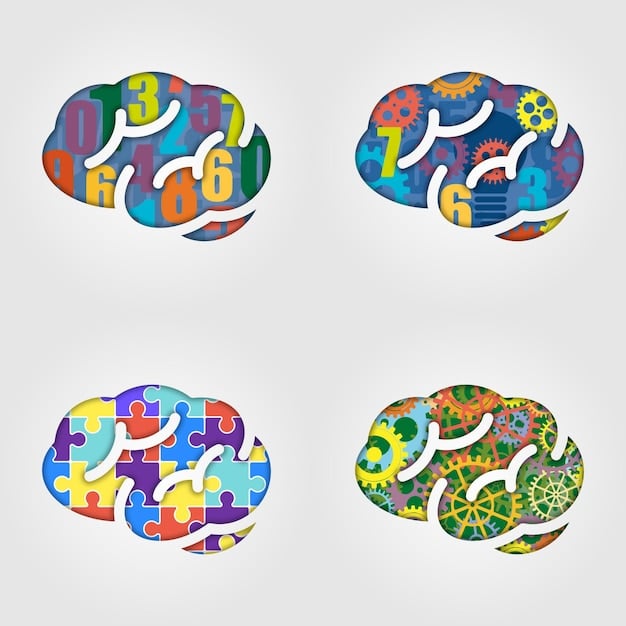Understanding Mental Health Stigma: Breaking Barriers & Seeking Help

Understanding the stigma around mental health involves recognizing societal attitudes that lead to discrimination and shame, and actively dismantling these barriers to encourage help-seeking behaviors and promote overall well-being.
The topic of mental health is often shrouded in silence due to persistent stigma. Understanding the stigma around mental health is the first step toward breaking down barriers and creating a society where seeking help is not only accepted but encouraged.
Understanding the Roots of Mental Health Stigma
Mental health stigma isn’t a modern invention; it has deep roots in history and culture. Exploring its origins helps us understand why it persists and how we can effectively combat it.
Historical Perspectives on Mental Illness
Historically, mental illness was often misunderstood and attributed to supernatural causes. This led to ostracization and inhumane treatment. Early asylums, rather than providing care, frequently served as prisons where individuals were subjected to cruel practices.
Cultural and Societal Influences
Cultural beliefs and societal norms play a significant role in shaping attitudes toward mental health. In some cultures, mental health issues are seen as a sign of personal weakness or failure, leading to shame and secrecy.
- Media portrayals often perpetuate stereotypes, depicting individuals with mental illness as violent or unpredictable.
- Lack of education and awareness contributes to misunderstandings and fear.
- Social pressure to appear “normal” can discourage individuals from seeking help.
Breaking down these deeply ingrained stigmas requires a multifaceted approach that includes education, awareness campaigns, and changes in media representation. By understanding the historical and cultural roots of mental health stigma, we can begin to dismantle the barriers that prevent people from seeking the help they need.

The Impact of Stigma on Individuals and Communities
The stigma surrounding mental health has far-reaching consequences, affecting not only individuals but also entire communities. Recognizing these impacts is crucial for fostering a more supportive and inclusive society.
Personal Consequences of Stigma
For individuals struggling with mental health issues, stigma can lead to feelings of shame, isolation, and hopelessness. These feelings can be intensely debilitating, making it harder to seek help and recover.
Community-Wide Effects
Stigma also affects communities by creating a climate of fear and misunderstanding. This can hinder the development of effective mental health programs and policies. When mental health issues are stigmatized, communities are less likely to invest in resources and support.
- Reduced access to mental health services due to fear of judgment.
- Increased rates of suicide and substance abuse.
- Difficulty finding employment and housing due to discrimination.
Addressing the impact of stigma requires a collective effort. Communities must work together to promote understanding, challenge stereotypes, and advocate for policies that support mental health. By creating a more accepting and supportive environment, we can empower individuals to seek help without fear of judgment.
Identifying and Challenging Common Misconceptions
One of the most effective ways to combat mental health stigma is to challenge common misconceptions. Many people harbor false beliefs about mental illness, which contribute to negative attitudes and discrimination.
Debunking Myths About Mental Illness
Many myths surround mental illness. For example, some believe that mental health conditions are a sign of weakness or that individuals can simply “snap out of it”. These myths are harmful and inaccurate.
Promoting Accurate Information
Accurate information is a powerful tool for challenging stigma. By educating ourselves and others about mental health, we can dispel myths and promote understanding. Reliable sources of information include mental health organizations, healthcare professionals, and scientific research.
- Mental illnesses are treatable conditions, just like physical illnesses.
- People with mental health conditions can lead fulfilling lives.
- Seeking help is a sign of strength, not weakness.
Challenging misconceptions requires ongoing effort and a commitment to spreading accurate information. By dispelling myths and promoting understanding, we can create a more informed and compassionate society.

Strategies for Reducing Stigma in Everyday Life
Reducing mental health stigma isn’t just about changing attitudes; it’s about taking concrete actions in our daily lives. Small steps can make a big difference in creating a more supportive and accepting world.
Language and Communication
The language we use to talk about mental health can have a powerful impact. Avoid using stigmatizing terms and phrases. Opt for respectful and inclusive language that emphasizes the person, not the condition.
Personal Actions and Advocacy
Individual actions can contribute to a culture of acceptance and support. Speak out against stigma when you see it. Share your own experiences with mental health, if you feel comfortable doing so. Support mental health organizations and advocate for policies that promote mental wellness.
- Share accurate information about mental health on social media.
- Participate in mental health awareness events.
- Support organizations that provide mental health services.
Reducing stigma is an ongoing process that requires commitment and effort. By taking action in our daily lives, we can contribute to a more compassionate and understanding world. Every small step helps to create a culture of acceptance and support for individuals struggling with mental health issues.
The Role of Media and Public Campaigns in Changing Perceptions
Media and public campaigns play a crucial role in reshaping perceptions of mental health. These platforms have the power to reach a wide audience and influence attitudes on a large scale.
Positive Media Representation
When the media portrays mental health issues accurately and respectfully, it can reduce stigma and promote understanding. Portrayals of individuals leading fulfilling lives with mental health conditions can inspire hope and encourage others to seek help.
Effective Public Awareness Campaigns
Public awareness campaigns can educate the public about mental health, challenge stereotypes, and encourage help-seeking behaviors. These campaigns often use personal stories, expert opinions, and scientific data to convey their message.
- Featuring diverse voices and experiences.
- Providing information about mental health resources.
- Encouraging open conversations about mental health.
The impact of media and public health campaigns should not be disregarded. These platforms have the potential to create widespread awareness, promote empathy, and drive change in attitudes and behaviors related to mental health.
Available Resources and Support Systems
Knowing where to find help is essential for anyone struggling with mental health challenges. Access to resources and support systems can make a significant difference in recovery and well-being.
Local and National Organizations
Numerous organizations offer mental health services and support. These include local community centers, national non-profits, and government agencies. These resources provide a range of services, from counseling and therapy to support groups and crisis intervention.
Online and Digital Resources
The internet offers a wealth of mental health resources, including websites, apps, and online support communities. These digital tools can provide information, self-help strategies, and access to virtual therapy.
- Mental health websites and blogs offer articles, videos, and podcasts.
- Mobile apps provide tools for tracking mood, managing stress, and practicing mindfulness.
- Online support communities offer a safe space to connect with others who understand what you’re going through.
From traditional organizations to modern-day technology, there are many avenues for seeking help and support. Empowering community members with resources can improve lives drastically and can foster a community of understanding.
| Key Point | Brief Description |
|---|---|
| 🧠 Roots of Stigma | Mental health stigma has historical and cultural origins, impacting current views. |
| 💔 Impact of Stigma | Stigma leads to isolation, reduces help-seeking, and can affect community resources. |
| 🗣️ Challenging Myths | Accurate information dispels misconceptions and fosters better understanding. |
| 📣 Reducing Stigma | Use inclusive language, advocate, and support mental health initiatives. |
Frequently Asked Questions
Mental health stigma refers to negative attitudes, beliefs, and discrimination directed toward individuals with mental health conditions. It creates shame and isolation.
Stigma can lead to reluctance to seek help, social isolation, discrimination in employment and housing, and feelings of shame and hopelessness.
Common myths include the belief that mental illness is a sign of weakness, that individuals can simply “snap out of it,” and that people with mental illnesses are violent.
You can challenge stereotypes, use inclusive language, share accurate information, support mental health organizations, and advocate for supportive policies.
You can find help from local community centers, national organizations, online resources, and mental health professionals. Seeking help is essential for recovery.
Conclusion
Understanding the stigma around mental health is a crucial issue that requires a collective and sustained effort. By addressing stigma, promoting understanding, and providing support, we can create a world where mental wellness is valued and prioritized for everyone.





